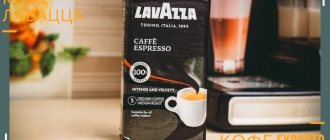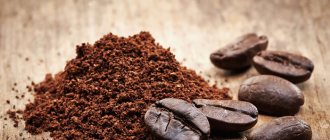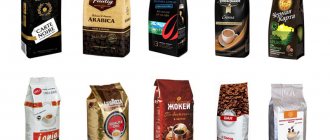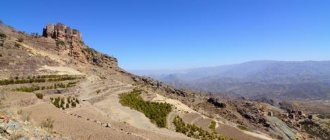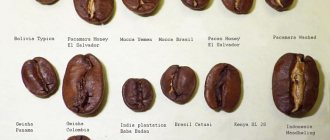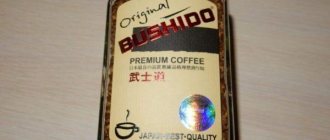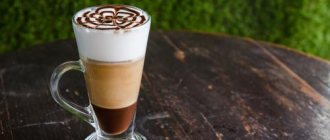Liberica (Cofféa liberica) is a type of coffee of industrial importance, but much less common than Arabica or Robusta. Liberica's share of the global coffee market is only 1%. This species is cultivated in West and Central Africa, Malaysia, Indonesia, India, the Philippines, Sri Lanka, Seychelles, Venezuela, Brazil and Colombia.
Origin of the variety
Liberian coffee originates from West Africa. Today, this species is grown in almost all countries of the African continent, as well as on the islands of Sri Lanka, Indonesia, the Philippines and others. Liberica coffee is obtained from the fruits of coffee trees with very large leaves and a height of 6-10 meters. The length of the coffee bean is 30-35 mm, its width is 10-15 mm. Liberica is resistant to all diseases of coffee trees, except rust fungus. The quality of Liberica fruits is not the highest, the yields are very low, so it is rarely used as a separate variety of coffee. Liberica is most often used to create various mixtures.
Taste and aroma qualities
If you roast Liberica beans and make a drink from them, it will have a sharply noticeable bitterness. In this case, the taste will remain “empty” and unexpressed. The variety contains little caffeine - about 0.8-1.2% (for comparison: in Arabica - 1.2-1.3%, and in Robusta - 2.5-3%). Therefore, you can drink several cups of the drink, but it will always seem diluted and watery. The gourmet will not receive the expected boost of energy and pleasure.
The aroma of liberica is rich, pronounced, full, dense, slightly jasmine. The smell of the beans is much more intense than that of Arabica, which is why they are added to coffee blends and are not consumed as a single type. IMPORTANT Liberica is used in small quantities in blends. Most often combined with robusta, which does not have a pronounced taste and aroma, but has a high caffeine content.
History of the Liberica variety
This type of coffee was discovered for widespread use only in the 20th century. in Guinea. It was found at the end of the 18th century in the forests of Liberia (hence the name of this species) by Carl Linnaeus' student Adam Afzelius. Later, this species was found in Cote D'Ivoire. Of all the existing botanical varieties of coffee trees, Liberica trees are the most slender and tall (height can reach 18 meters). This coffee tree grows only north of the equator and is very difficult to find on plantations. Liberica makes up only 2% of the coffee trees grown on coffee plantations. However, the reason for such unpopularity of this botanical variety is not at all the climatic preferences of the Liberica coffee tree - the drink made from Liberica beans has an unsaturated, “empty” taste and is not in demand among coffee lovers. The caffeine content of Liberica can vary from 0.7% to 2.4%. This type of coffee is used mainly in the confectionery industry, therefore, when talking about the types of coffee used to prepare the popular drink, liberica is usually not mentioned at all.
Conclusions:
- Liberica is the third most popular coffee variety in the world.
- In its pure form it is used only locally and is mainly exported.
- The grains are very large, up to 3.5 cm in length, in appearance - the same as Arabica, just larger.
- The natural taste is weak, watery, sharply bitter. But the natural aroma is stronger than that of other varieties.
- Used primarily to enhance the aroma in coffee blends, as well as in the confectionery industry, the flowers are used to make tea with a strong jasmine aroma.
How to grow Liberica
The Liberica coffee tree differs from other types of flora in its beauty. The usual height of the plant is about 6-8 meters, but sometimes it reaches a length of 10 meters. The tree has large, beautiful leaves that look like a fan. The length of one coffee bean is 3-4 centimeters, width - 1-1.5 centimeters.
For the plant to begin to bear fruit, the climate must be hot and humid. If the conditions are not met, the tree does not die, but stops producing crops. After heavy rains, Liberica revives and begins to bear fruit again.
The plant does not require special care. It is resistant to diseases and is not afraid of insects; it does not require special care or treatment. From a cultivation point of view, the variety is very economical, although it has low yield.
In Malaysia
The only place in the world where this type of coffee occupies the overwhelming area of plantations (more than 90%) is Malaysia. The country produces approximately 10,000 tons of beans per year, a volume that accounts for 0.01% of the global coffee market.
Ripe fruits are collected using the picking method (only ripe berries are carefully removed by hand). The technology makes it possible to achieve a uniform harvest. This coffee is considered the highest grade and has a rich taste.
Have you tried drinks with Liberica coffee?
Yes
No
The local population prefers Liberica; imported varieties are not popular with them. The grains of the plant are processed using wet or honey methods. In Malaysian cafes - kopitiams - you can try traditional Liberica drinks. There are several popular recipes, for example: grains are caramelized over fire in sugar, which gives the drink a peculiar sweetish taste. Ipoh “white” coffee, which is roasted in butter, is also popular.
In the Philippines
Locals call this coffee Barako (Kapeng Barako). After severe frosts in 1886-1888, which destroyed Arabica and Robusta coffee plantations in Latin America, the time of Philippine liberica came. Grains began to be supplied to neighboring countries and the share of production increased significantly. But, in the first decades of the 20th century, the variety began to lose popularity, and the more productive robusta began to be used instead.
In the 90s of the 20th century, Philippine liberica completely lost its glory. The reason was the activities of unscrupulous businessmen who mixed Barako with cheap Vietnamese excelsa. The consumer did not like the flavor combination; the drink turned out bitter and “empty.” So farmers began removing liberica from their fields and replanting them with more profitable coffee varieties. For the last 20 years, they have been trying to restore Barako in the Philippines.
In Sri Lanka
Coffee on the island is not a very common product, so it is very valuable. Until the second half of the 19th century, Sri Lanka was known for its high-quality grain drink, but after the appearance of the fungus Hemileia vastatrix on the island, the plants died. To avoid financial distress, coffee trees were replaced by tea bushes and Ceylon gained fame as the Tea Empire.
Currently, the humid and warm climate allows Liberica to be propagated on the island without hassle. Trees are not planted on plantations on purpose, but grow in the natural environment. In Sri Lanka, this variety is not consumed in its pure form; it is added to coffee combinations to make the taste of the drink deeper and more interesting.
Different and the same
But regardless of what type/variety of coffee we are talking about, all fruits have the same structure and consist of:
- longitudinal groove and seed;
- seed coat and parchment shell;
- fruit part and pectin layer;
- outer fruit shell.
True, the end consumer is of little interest in the structure of the fruit, because, as a rule, they choose coffee by taste and aroma, and some even by price. Return to content
The present and future of Liberica
The same problem happened with Liberica as with Robusta: almost everywhere, except Malaysia, they stopped monitoring the quality of the grains and the thoroughness of their processing. It is not surprising that in many countries Liberica plantations are on the verge of destruction.
Over the past few years, there has been a real liberica renaissance. It turned out that it is not so low-yielding: if the cultivation and harvesting technology is followed, 5 kg of green coffee beans per year are obtained from one tree, up to 4 tons per hectare.
Premium Liberica is popular with coffee lovers. Most popular brands:
- India Anohki Coffe – 100% Liberica with hints of chocolate, honey and anise on the palate;
- My Liberica (Malaysia) - a whole line of 100% liberica, which includes honey-processed peaberries (with nutty and jasmine notes in the taste), regular light roast beans (with a taste of jasmine and milk chocolate), wet-processed, and dark roast coffee.
How is Liberica used?
This type of coffee is rarely sold in its pure form. Due to the bitter taste and lack of an invigorating effect, the drink does not have many fans. Liberica is often used in production:
- Coffee blends , which can consist of Arabica, Robusta and a small portion of Liberica. Without Robusta, the drink loses strength, without Arabica it turns out too bitter, and without Liberica it is not so aromatic.
- Jasmine tea . During flowering, Liberian coffee has a jasmine aroma. Therefore, dried flowers are added to tea as a natural flavor enhancer.
- Confectionery products . Liberica gives cakes and cakes a pleasant smell of fresh coffee. Natural flavoring does not add an invigorating effect to baked goods, because... the beans contain small amounts of caffeine.
- Instant coffee . It is added to other varieties to make the taste more pronounced.
Botanical features of Liberica
Liberica is native to Central and Western Africa; in the wild, this species is found from Liberia to Uganda and Angola. The trees grow very tall, up to 18 m. But on plantations they are pruned at a height of 1.5 m, forming a dense crown. Their flowers are larger than other types of coffee trees and smell like jasmine. In Asia and Africa, jasmine tea is even made from liberica flowers, and only connoisseurs can distinguish it from the real thing by its subtle coffee notes.
Large berries ripen in about 14 months. Flowers, ovaries and ripe fruits can simultaneously be on one branch. Liberica grains are almond-shaped, large, measuring 10–15 × 20–25 mm.
The aroma of the beans is rich and very intense. In Asia, Liberica is called "coffee jackfruit", comparing its smell with the fragrance of the sweet fruit of the Indian breadfruit. The aroma of liberica flowers and fruits is pleasant to humans, but repels insect pests.
However, the taste of Liberica coffee leaves much to be desired: it is too bitter and hollow. There is relatively little caffeine in the beans: 0.7–1.5%.
Scientists argue about the botanical classification of liberica. Previously, it and Excelsa were considered separate species, but since 2006 it has been proposed that Excelsa be considered a variety of Liberica. However, Liberica and Excelsa beans are too different in taste and aroma, so they are not usually mixed.
Unlike the mountain Arabica, Liberica grows in warm, humid lowlands, at an altitude of 200–400 m above sea level, although in the Philippines some plantations are planted at an altitude of 900 m, and in Malaysia - at 1200 m. Liberica requires clayey, well-drained soils. soil, and a little shade. However, in Malaysia, plantations are laid out under the scorching sun, which does not prevent the trees from bearing fruit. Liberica thrives even where the relatively hardy robusta cannot grow: on poor, heavy clay soils, even with an acidity of pH 4.0, without requiring liming.
Beans before roasting
Liberica tolerates both excessive soil moisture and excessive dryness equally poorly. During drought, the tree stops bearing fruit. But if Arabica under unfavorable conditions loses its ability to bear fruit forever, then on Liberica, as soon as the drought ends, flowers and ovaries appear again.
The tree reproduces by seeds. Their germination rate is so high that sometimes the seedlings are not specially grown, but are simply dug up under the mother tree.
Less hardy Arabica is often grafted onto Liberica. Such trees are resistant to disease and can withstand the vagaries of the weather more easily than ordinary Arabica.
